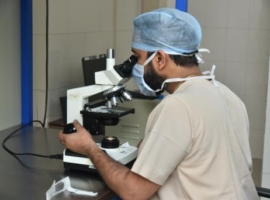Management of a Challenging Case of Infertility
Overview of the Case
A couple from Ghatkopar came to us with complaints of inability to conceive. They were a young couple both aged 30 years, married for 5 years and were trying to conceive for the past 2 years. They had no other presenting complaints. They had no history of addictions or of any major medical/surgical illness in the past. The female partner’s menstrual cycles were regular , painless – 3-4/26 days. She had visited us on day 2 of periods. They were not investigated in the past.
Departmental transvaginal ultrasound was done and the findings were-
-Antral follicular count (AFC) of 1-2 in each ovary. (Normal AFC at this age is 8-10 per ovary)
– Right sided endometrioma -1.8 x1.5 cms
-Left sided endometrioma-3.2 x2.8 cms
– Uterus –normal
Basic investigations pertaining to subfertility were ordered and we decided to do natural cycle follicular monitoring in that month at the IVF hospital in Powai.
Investigations were:
- Anti Mullerian Hormone( AMH )-0.47ng/ml
Normal range –
optimal fertility – 4.0 -6.8 ng/ml
Satisfactory fertility – 2.2 – 4.0 ng/ml
Poor fertility – 0.3 – 2.2 ng/ml
Very poor fertility – <0.3 ng/ml
2) TSH – 1.568
3)Prolactin -9.9
4)Hb electrophoresis- no thal. variant
5)Rubella IgG- Positive
6)RBS- 92mg/dl
7)HBA1C- 5.2
8)Husbands semen Analysis
Normal Range
Sperm count- 12 million /ml >15mill/ml
Motility – 30 % 40%
Grade A – 10 % 32%
Grade B- 20 %
Non motile sperms – 70 %
9)Natural cycle departmental Follicular monitoring was done
Findings:
Day 12 – mature 20 mm follicle with endometrial lining of 7 mm.(Normal range 9 -12 mm)
10)3D ultrasound from radiology department confirmed the presence of uterine septum
There were multifactorial reasons for subfertility
1.Low AMH & Low antral follicular count
- Bilateral endometriomas
- Thin endometrial lining – uterine septum
- Boderline sperm count and motility
Options given :
1) One cycle of IVF/ICSI —-Freezing of embryos ——– Hysterolaparoscopy ——2nd cycle of IVF/ICSI ——Embryo transfer of the best embryos.
2) Hysterolaparoscopy + PRP of ovary——-IVF/ICSI——— Embryo transfer
3) Donor egg program
In depth counseling of the couple was done and we finally decided on the second option -Hysterolaparoscopy + PRP of ovary——-IVF/ICSI——— Embryo transfer
Surgery done – Laparoscopic bilateral ovarian cystectomy with cauterization of pelvic endometriosis + hysteroscopic resection of uterine septum+PRP of the ovary.
Post surgery a single dose of GnRH agonist – 3 monthly dose of Inj. Lupride depot 11.25 mg was given to suppress the microdeposits and prevent recurrence of endometriosis.
Adjuvant medical therapy with DHEA, micro nutrients & coenzyme Q was given for 3 months
. Husband was also prescribed antioxidants to improve quality of the sperms.
After three months, Ovarian stimulation with gonadotropins was done
On day of oocyte retrieval we got two ooctyes and ICSI was done .
On day of oocyte retrieval the endometrial lining was 10 mm triple line .
100 % fertilization obtained and fresh embryo transfer was done on day 3 ,luteal phase was given and beta hcg done after 14 days showed a positive result. First trimester was uneventful.
She had a full term LSCS and healthy baby weighing 3.2 kg was delivered
High lights of the case.
- One of the most recent Advances in Reproductive medicine was adopted – OVARIAN REJUVINATION –PRP of the OVARY.
IVF treatment in Powai with Platelet-rich plasma (PRP), also known as autologous conditioned plasma, is a concentrate of platelet -rich plasma protein derived from whole blood and centrifuged to remove red blood cells.
PRP contains higher-than-normal levels of cytokines and growth factors, including platelet-derived growth factor (PDGF), insulinlike growth factors (IGFs) 1 and 2, interleukin (IL)-8, keratinocyte growth factor (KGF), epidermal growth factor (EGF), connective tissue growth factor (CTGF), fibroblast growth factor (FGF), and transforming factors.
Over the last 20 years, we are finding a rapid decline in the ovarian reserve
More and more women are suffering from poor ovarian reserve at a younger age
This could be a result of environmental pollution, toxic substances or fertilizers in our food or maybe the stressful situations that we live in. Whatever may be the reason, the fact remains that fertility is going down rapidly.That is why there are more and more attempts to find drugs and procedures to reverse this ageing process.The theory behind PRP was deived from natural healing process as the body’s first response to tissue injury is to deliver platelets to the injured area. Platelets promote healing and attract stem cells to the site of injury. The best IVF hospital in Mumbai Autologus PRP is derived from the whole blood of the same individual centrifuged to remove RBC’s. The remaining plasma has a higher concentration of a cocktail of growth factors 5 to 10 folds greater than the whole blood.






There are no comments